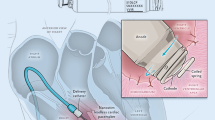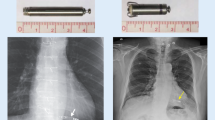Summary
The concept of small surface high impedance pacing electrodes is based on three major arguments: 1) tip size reduction increases the field strength at the electrode surface; 2) a micro-porous coating allows for downsizing the geometric surface area to about 1 mm2 without increasing the voltage pacing threshold; and 3) small electrodes exhibit high pacing impedance hence reduce the charge transfer from the battery through the electrode-tissue interface. This design does not compromise sensing if the input impedance of the amplifier used is adequate (>30kΩ). In the long term (2 up to 5 years post-implant), typical impedance values range between 900 and 1200Ω, pacing thresholds are below 1.0V @ 0.5 ms, and the minimum charge delivered per pulse is around 0.2μC. Careful implantation is a prerequisite of good long term performance and does not bear additional risks of myocardial perforation or excessive threshold rise as compared to the normal (5.8 mm2) electrode size. The benefit in terms of battery drain is maximum with nominal output parameters (≥2.5 volt); when pacing below the battery voltage, however, the difference in pacemaker longevity is marginal between normal and high impedance “low threshold electrodes”. This energy balance may change in favor of high impedance leads if the current drain of the circuitry will be lowered in next generation pacing devices.
Zusammenfassung
Das Konzept kleinflächiger Elektroden mit hoher Stimulationsimpedanz gründet sich darauf, dass die Miniaturisierung des Elektrodenkopfs die lokale Feldstärke erhöht, dass bei mikroporöser Beschichtung geometrische Stimulationsflächen um 1 mm2 ohne Anstieg der Spannungsreizschwelle realisierbar sind und dass damit der Widerstand an der Phasengrenze zwischen Elektrode und Gewebe so weit erhöht wird, dass signifikant weniger (Batterie-) Ladung ins Gewebe abfließt. Die Reizschwelle zwei bis fünf Jahre nach Implantation liegt deutlich unter 1,0 Volt bei 0,5ms Impulsbreite, und bei typischer Impedanz zwischen 900 und 1200Ω reicht eine Ladungsmenge von 0,2 μC pro Impuls zur Stimulation des Herzens aus. Durch Reduktion der geometrischen (nicht der elektrochemisch aktiven) Elektrodenoberfläche wird die Wahrnehmung kardialer Signale an Verstärkern mit hoher Eingangsimpedanz nicht verschlechtert. Eine dauerhaft gute Funktion von Hochimpedanz-Elektroden bedarf sorgfältiger Implantationstechnik, wobei im Vergleich mit Elektroden konventioneller Bauart die Perforationsgefahr und das Risiko von Ausreißern bei der Reizschwellenentwicklung nicht signifikant erhöht ist. Hochimpedanz-Elektroden reduzieren den Stimulationsstrom bei nominalen Ausgangsparametern (≥2,5 Volt) am meisten, während der Laufzeitgewinn bei Stimulationsamplituden unterhalb der Batteriespannung im Vergleich hoch- und niederohmiger „Low-Threshold-Elektroden” nur marginal ist. Mit Senkung des Inhibitionsstroms moderner Schrittmacher-Aggregate könnte diese Bilanz sich zugunsten des Hochohm-Konzepts verschieben.
Similar content being viewed by others
Author information
Authors and Affiliations
Additional information
Eingegangen: 2. April 2001 Akzeptiert: 13. April 2001
Rights and permissions
About this article
Cite this article
Fröhlig, G. Hochohm-Elektroden. Herzschr Elektrophys 12, 131–140 (2001). https://doi.org/10.1007/s003990170017
Published:
Issue Date:
DOI: https://doi.org/10.1007/s003990170017




